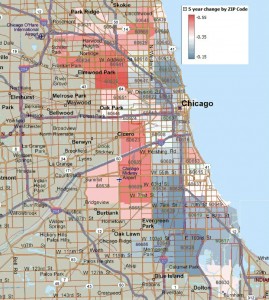 I don’t normally pay any attention to Zillow because I think their attempts to put a value on an individual home are horribly inaccurate. However, I believe their aggregate data can be quite informative since many of the inaccuracies probably average out.
I don’t normally pay any attention to Zillow because I think their attempts to put a value on an individual home are horribly inaccurate. However, I believe their aggregate data can be quite informative since many of the inaccuracies probably average out.
That’s why when I recently discovered their Chicago home price change data by zip code I thought it would be instructive to see what we could learn from it. Their data includes the 5 year annualized home price change for each of the Chicago zip codes. 5 years is a good time period to look at because it roughly corresponds to the time period since the housing bubble peaked in Chicago. By compounding their data I was able to determine the cumulative price changes and then display the results on the heat map above.
Clicking on that map you will go to a much larger version and, depending upon the size of your monitor, you may be able to click the larger image again for an even bigger version. As the legend shows the heat scale goes from – 15% (dark blue) to -55% (dark red). In reality the range is -19% to -53%. Yeah, -19% is good. If you would like to see the actual data you can scroll through the spreadsheet below.
So there you have it. There are some dramatic differences between zip codes in terms of home price changes. Duh! Overall the city of Chicago had a price decline of almost 34%, which is quite consistent with the Case Shiller Home Price Index. So that gives me some degree of confidence in the data. However, as expected, the central part of the city didn’t do as poorly as some of the outer areas – in particular Lake View and Lincoln Park held up OK. And zip code 60653 on the south side didn’t do so well. However, other areas on the south side held up better than I expected.
All of this data just reinforces the point that you can’t expect the averages to apply to every situation – certainly not to your own special circumstances. Expecting otherwise just leads to disappointment and bewilderment – i.e. Why can’t I get a deal? Over the next few weeks I hope to present some real life examples of some specific areas of Chicago and specific buildings for everyone’s amusement and education.